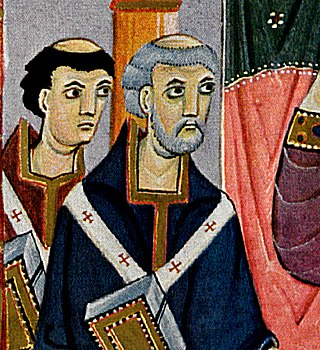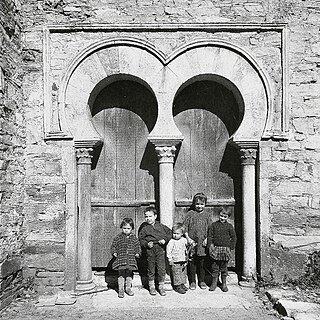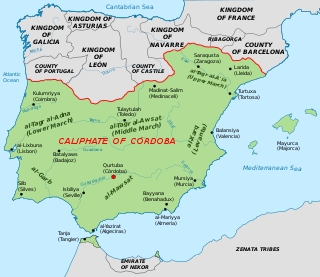Related Research Articles

Pope Sylvester II, originally known as Gerbert of Aurillac, was a scholar and teacher who served as the bishop of Rome and ruled the Papal States from 999 to his death. He endorsed and promoted study of Moorish and Greco-Roman arithmetic, mathematics and astronomy, reintroducing to Western Christendom the abacus, armillary sphere, and water organ, which had been lost to Latin Europe since the fall of the Western Roman Empire. He is said to be the first in Christian Europe to introduce the decimal numeral system using the Hindu-Arabic numeral system.

The Mozarabs, or more precisely Andalusi Christians, were the Christians of al-Andalus, or the territories of Iberia under Muslim rule from 711 to 1492. Following the Umayyad conquest of the Visigothic Kingdom in Hispania, the Christian population of much of Iberia came under Muslim control.
A kharja or kharjah, is the final refrain of a muwashshah, a lyric genre of al-Andalus written in Arabic or Andalusi Romance ("Mozárabic").

Al-Andalus was the Muslim-ruled area of the Iberian Peninsula. The term is used by modern historians for the former Islamic states in modern-day Gibraltar, Portugal, Spain, and Southern France. The name describes the different Muslim states that controlled these territories at various times between 711 and 1492. At its greatest geographical extent, it occupied most of the peninsula and part of present-day southern France (Septimania) under Umayyad rule. These boundaries changed constantly through a series of conquests Western historiography has traditionally characterized as the Reconquista, eventually shrinking to the south and finally to the Emirate of Granada.

Abū Isḥāq Ibrāhīm ibn Yaḥyā al-Naqqāsh al-Zarqālī al-Tujibi ; also known as Al-Zarkali or Ibn Zarqala (1029–1100), was an Arab maker of astronomical instruments and an astrologer from the western part of the Islamic world.

Andalusi Romance, also called Mozarabic or Ajami, is the varieties of Ibero-Romance that developed in Al-Andalus, the parts of the medieval Iberian Peninsula under Islamic control. Romance, or vernacular Late Latin, was the common tongue for the great majority of the Iberian population at the time of the Umayyad conquest in the early eighth century, but over the following centuries, it was gradually superseded by Andalusi Arabic as the main spoken language in the Muslim-controlled south. At the same time, as the northern Christian kingdoms pushed south into Al-Andalus, their respective Romance varieties gained ground at the expense of Andalusi Romance as well as Arabic. The final extinction of the former may be estimated to 1300 CE.
Abu Tawr was wali of Washka, a Muslim nobleman, perhaps member of the Banu Salama clan. Alternatively, it has been suggested that he may be the individual Al-Andalus genealogist Ibn Hazm named as Abu Tawr ibn Qasi, son of the eponymous ancestor of the powerful Muwallad Banu Qasis.

Medieval Islamic astronomy comprises the astronomical developments made in the Islamic world, particularly during the Islamic Golden Age, and mostly written in the Arabic language. These developments mostly took place in the Middle East, Central Asia, Al-Andalus, and North Africa, and later in the Far East and India. It closely parallels the genesis of other Islamic sciences in its assimilation of foreign material and the amalgamation of the disparate elements of that material to create a science with Islamic characteristics. These included Greek, Sassanid, and Indian works in particular, which were translated and built upon.
Abu al-Qasim Maslama ibn Ahmad al-Majriti, known or Latin as Methilem, was a Muslim Arab astronomer, alchemist, mathematician, economist and Scholar in Islamic Spain, active during the reign of Al-Hakam II. His full name is Abu 'l-Qāsim Maslama ibn Aḥmad al-Faraḍī al-Ḥāsib al-Maj̲rīṭī al-Qurṭubī al-Andalusī.

The Toledo School of Translators is the group of scholars who worked together in the city of Toledo during the 12th and 13th centuries, to translate many of the Islamic philosophy and scientific works from Classical Arabic into Medieval Latin.

The Taifa of Seville was an Arab kingdom which was ruled by the Abbadid dynasty. It was established in 1023 and lasted until 1091, in what is today southern Spain and Portugal. It gained independence from the Caliphate of Cordoba and it expanded the territory it ruled in the mid-11th century. The emerging power of Castile led Seville to ask military assistance from the Almoravids, who then occupied Seville.
Ibn al-Qūṭiyya, born Muḥammad Ibn ʿUmar Ibn ʿAbd al-ʿAzīz ibn ʾIbrāhīm ibn ʿIsā ibn Muzāḥim, also known as Abu Bakr or al-Qurtubi, was an Andalusian historian and considered the greatest philologist at the Umayyad court of caliph Al-Hakam II. His magnum opus, the History of the Conquest of al-Andalus, is one of the earliest Arabic Muslim accounts of the Islamic conquest of Spain.
Abu al‐Qasim Ahmad ibn Abd Allah ibn Umar al‐Ghafiqī ibn as-Saffar al‐Andalusi, also known as Ibn as-Saffar, was a Spanish-Arab astronomer in Al-Andalus. He worked at the school founded by his colleague Al-Majriti in Córdoba. His best-known work was a treatise on the astrolabe, a text that was in active use until the 15th century and influenced the work of Kepler. He also wrote a commentary on the Zij as-Sindhind, and measured the coordinates of Mecca.

The Emirate of Córdoba, from 929, the Caliphate of Córdoba, was an Arab Islamic state ruled by the Umayyad dynasty from 756 to 1031. Its territory comprised most of the Iberian Peninsula, the Balearic Islands, and parts of North Africa, with its capital in Córdoba. From 756 it was ruled as an emirate until Abd al-Rahman III adopted the title of caliph in 929.

Abu-l-Hasan Ali ibn Ruburtayr or Reverter was the younger son of Reverter I viscount of Barcelona, and a Muslim Catalan mercenary commander. He left the Christian faith and territories, and converted to Islam. His Christian name is unknown.
The Barcelona astrolabe is the oldest astrolabe with Carolingian characters that has survived in the Christian Occident. The French researcher Marcel Destombes founded the astrolabe, and left it as legacy to the Institute of the Arab World of Paris in 1983.
Abū al‐Qāsim Aṣbagh ibn Muḥammad ibn al‐Samḥ al‐Gharnāṭī al-Mahri, also known as Ibn al‐Samḥ, was an Arab mathematician and astronomer from Al-Andalus. He worked at the school founded by Al-Majriti in Córdoba, until political unrest forced him to move to Granada, where he was employed by Ḥabbūs ibn Māksan. He is known for treatises on the construction and use of the astrolabe, as well as the first known work on the planetary equatorium. Furthermore, in mathematics he is remembered for a commentary on Euclid and for contributions to early algebra, among other works. He is one of several writers referred to in Latin texts as "Abulcasim."
Kitāb al-Anwāʾ is a title given to a number of works from eastern and western parts of Arab civilization that concern astronomy, weather and agriculture. There is no proven relation between the different works of this title: the Kitāb al-Anwāʾ by Abu Hanifa Dinawari of Iran, for example, was written more than a century earlier than the Kitāb al-Anwāʾ by ʿArīb ibn Saʿīd al-Qurṭūbī of Córdoba. This latter, however, was a particularly influential example of the form and was adapted and translated several times.
The literature of al-Andalus, also known as Andalusi literature, was produced in al-Andalus, or Islamic Iberia, from the Muslim conquest in 711 to either the Catholic conquest of Granada in 1492 or the expulsion of the Moors ending in 1614. Andalusi literature was written primarily in Arabic, but also in Hebrew, Latin, and Romance.
The Verona astrolabe is an archaeological discovery unearthed in the vaults of a museum in Verona, Italy. Dating back to the eleventh century, this Islamic astrolabe is one of the oldest examples of its kind and is among the few known to exist worldwide. It appears to have been employed by Muslim, Jewish, and Christian communities spanning Spain, North Africa, and Italy over several centuries.
References
- Juan Vernet, The pursuit of learning - Moorish rule in Spain - Al-Andalus: where three worlds met, UNESCO Courier, Dec 1991. Archived 2006-06-21 at the Wayback Machine